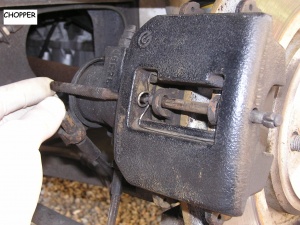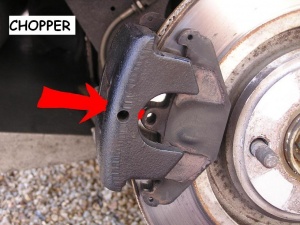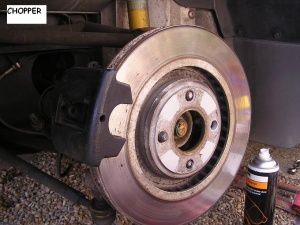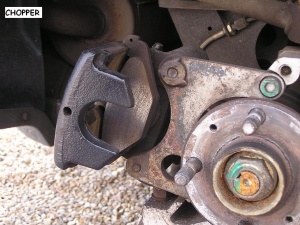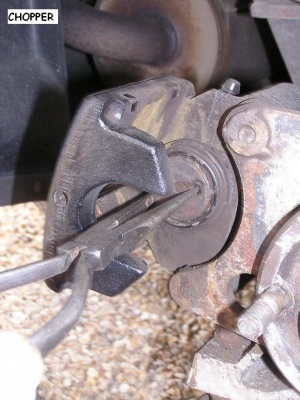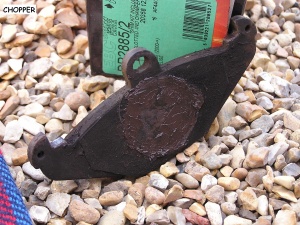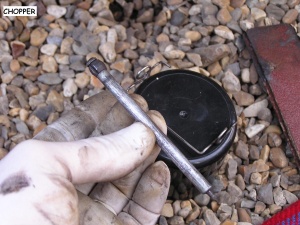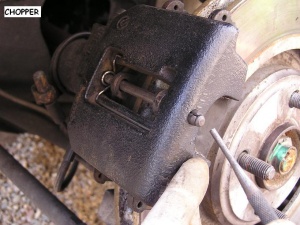Brakepad, rear change
This is the procedure for changing rear pads on an S1 Elise. (Its the same caliper on the K series S2 models and most likely still in use on the Tonka Toy engined cars)
1. Jack up the car and remove the rear wheel
2. Remove the pad retaining pin. You willl need a thin screwdiver/bar or preferably a pin punch to knock out the retaining pin. Insert the punch in the small hole in rear of caliper and knock the retaining pin towards the outside. The hole is much smaller at the back than the one you see at the front
***BE CAREFUL YOU DO NOT LOSE THE SMALL ANTI-RATTLE SPRING (Bendy wire bit straddling disc). It may ping out as you knock the pin past it****
3. With the pin removed, knock the outer pad inward to release.
4. To get to the rear pad you require to remove the disc. Its not held on by anything other than the road wheel clamping it against the hub. The disc is likely to be stuck to the hub by road gunk/corrosion. Wire brush the end of the hub where it sticks through the disc.
If it still will not move, use a large piece of wood, a soft faced hammer or a metal hammer with a wood block between hammer and disc.
From the rear. Strike the top and bottom of the disc alternate blows (as you rotate the disc) and the disc will start moving off the hub.
***Don't hit the disc directly with a metal hammer. Brake discs are brittle and it will crack. ***
5. Remove the rear pad. Its not held in with anything once the disc is removed
6. Use a set of thin nosed pliers to push in (hard) while rotating clockwise, to screw the caliper piston back in.
Straight ended pliers will allow you to push with your body weight.
***BE CAREFUL THAT YOU DO NOT SKID OFF THE PISTON WITH THE PLIERS AND PUT A HOLE IN THE RUBBER DUST GAITOR--- EASILY DONE***
(Caliper windback tools are available if you don't fancy using pliers)
If you are fitting new pads then release the cap from the fluid reservoir and use a turkey baster to suck out some fluid. ****Don't take too much out that you'll let air get into the pipework**. Screw in the caliper/check level/remove fluid if needed /screw in some more/repeat if in doubt
7. Apply a thin smear of copper grease to the back of the pads. Look at the contact points on the back of the pads and only apply the grease on these points
8. To aid refitting, its worth cleaning the retaiing pin with some sandpaper and greasing lightly with copper grease
9. Replace the rear pad.
Making sure the hub face and the back of disc is clean (otherwise the disc will not run true), refit the brake disc
***ENSURE THE DISC IS FITTING AGAINST THE HUB AND NOT HELD OFF BY THE INNER PAD - should be OK is you've screwed the piston right in ****
10. Slip the outer pad into place.
Refit the retaining pin and the anti-rattle spring clip. ***MAKE SURE THE SPRING WASHER (small ring) AT THE END OF THE RETAINING PIN IS FULLY PUSHED INTO THE CALIPER TO ENSURE THE PIN IS SECURELY HELD (Shown still sticking out in this photo)
11. Refit the road wheel
12.
***IMPORTANT. Before driving anywhere. Press the brake pedal a few times to take up any gap between pad and disc....or you'll get a suprise the first junction you come to - VOE :-( ***
Some brake pads are supplied with stick-on anti-squeel pads. Some folk don't fit them as it adds a small amount of spongyness to the brake feel (the pad has to compress before the pad actually moves). Personal choice. Probably important if you are racing and need 100% brake control/are a driving God.... other folk fit just happy the brakes don't squeel
13. An alternative technique to that detailed above that requires a bit more work is to removing one of the rear caliper reatining bolts and tilt it back on the other. If you use this method you need to apply some threadlock on the caliper bolt when you re-bolt the caliper to its mount
